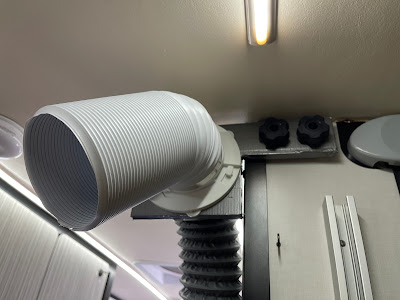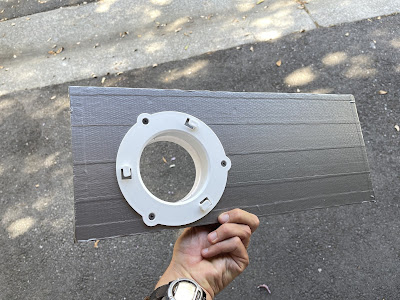We don't have a roof-top air conditioner, and we don't want one. (*If you really want to know why, read the asterisked note at the bottom.) However, about once per year we're forced to spend the night in extremely hot areas, so we decided to try a portable AC that we could use when we need it.
We bought a Zero Breeze Mark II, a small portable air conditioner that blows a steady stream of 62-degree air that can cool a very small space, like a tent, or serve as a spot cooler that blows cold air directly on you. In our case, we use it to cool the bedroom area and to blow directly on us while we sleep. In order to accomplish this, we created two different implementations for cooling the bedroom and ourselves: the Indoors configuration and the Outdoors configuration. I'll explain the two configurations in the following sections, and then talk about about the power consumption and thermodynamic performance at the end of this post.
TL;DR version: the Zero Breeze Mark II definitely can cool the bedroom area to make the space more comfortable; however, the most effective use of the ZeroBreeze is as a spot cooler, having it blow a chilly breeze on you while you sleep - - you'll need a blanket, because it's pretty darned cold.
INDOORS
The basic idea of the indoor implementation is that the Zero Breeze sits on the galley counter, drains into the sink, and blows cool air into the bedroom area which is separated from the rest of the van by a thermal blanket. Exhaust heat from the Zero Breeze is vented through the ceiling fan in the main cabin with an open window to exchange the air.
For this indoor implementation, I cut this wacky bracket out of plywood to serve as a removable support for the vent hose. I attached quick connect fittings to it for suspending the hose and to serve as a suspension point for the thermal barrier.
The thermal barrier is a tri-folded moving blanket that I put grommets in. The grommets hang from cup hooks. We point the vent tube directly at us and enjoy 62-degree air blowing on us while we sleep - - it's cold enough to require a good blanket for sleeping.
OUTDOORS
The outdoor configuration is probably the superior implementation for thermodynamic efficiency and noise abatement. In this configuration, the Zero Breeze is mounted outside, and blows a steady stream of 62-degree air through a port in the side window, cooling the space and the people near the air stream. We put our heads by the window and let the cold air wash over us - - it's very effective for staying cool, and will require a blanket for sleeping.
To accomplish this, I built a small shelf that attaches to our Vannon ladder. (The shelf should be painted black, but I haven't gotten to it yet.)
I cut some foam insulation into a size that fits tightly in the bedroom window, then cut a hole for air duct fixtures, covered the foam with gray duct tape, and attached the quick connect fixtures and duct connector flange to it. Finally, I attached a short length of air duct hose to the exterior part, long enough to clear the window.
Finally, I set the Zero Breeze on the shelf, lock it to the ladder with a strong combination lock, and plug the unit in to the 110-volt receptacle on the rear passenger side of the van.
As before, the entire kit packs tightly into a 20-gallon Husky waterproof tote. The downsides to this configuration are exposure to the elements, accessibility for theft or tampering, and it takes a little longer to set up.
POWER CONSUMPTION
Based on approximately 30 hours of usage, I've found that the Zero Breeze consumes an average of 17.5A. Since we have a RoamRig Stage 1 lithium system in our van with 420 Ah total capacity, a 10-hour overnight cooling session uses approximately 42% of our total capacity. Since we do not have a 2nd alternator for recharging the battery bank, this requires 4.5 hours of driving to recharge it (our single Sprinter alternator supplies 9.25% of battery capacity per hour).
PERFORMANCE
Although it's difficult to compare different air conditioning scenarios due to inherent atmospheric differences, I've captured some data from both the Indoor and Outdoor configurations to see how they compare.
OUTDOOR CONFIGURATION DATASET 1
OUTDOOR CONFIGURATION DATASET 2

INDOOR CONFIGURATION DATASET 3
THE BOTTOM LINE
* Why we don't want an air conditioner on the roof:
- We like the fresh air fan and the skylight that it creates;
- We live near the coast, and can always travel to someplace where it's cool;
- We don't like the looks of that big black box sitting up there;
- We don't like the aerodynamics of it;
- We don't want the extra weight.
01-September-2021
























1 comment:
This is great. Thanks for the detailed post. Nice, compact solution for the rare AC user.
Post a Comment